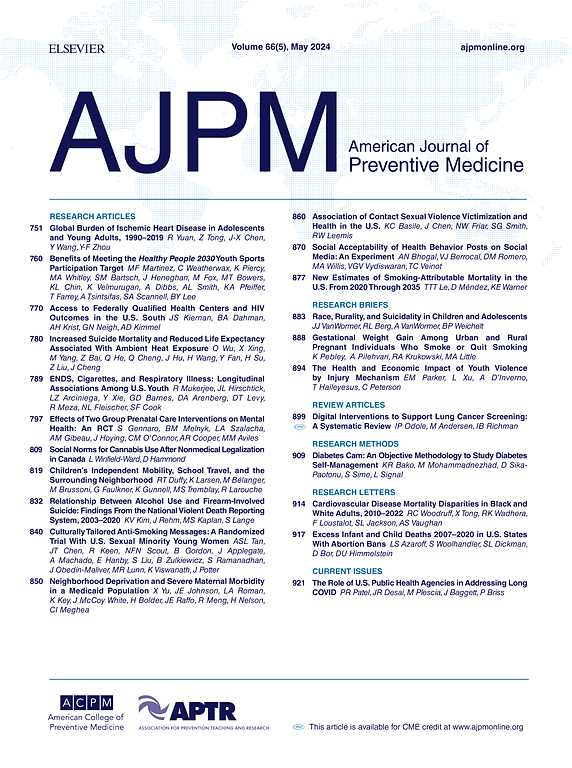丁丙诺啡配药后的x -豁免消除由临床医生的专业。
IF 4.5
2区 医学
Q1 MEDICINE, GENERAL & INTERNAL
引用次数: 0
摘要
x -豁免要求临床医生完成额外的注册才能开丁丙诺啡治疗阿片类药物使用障碍(OUD),取消了x -豁免,消除了治疗的一个障碍。本研究考察了临床医师专业的丁丙诺啡配药与x -豁免消除的关系。方法:使用IQVIA纵向处方数据,确定2021年5月至2024年12月每月分配丁丙诺啡15天及以上的患者。中断时间序列分析(进行于2025年)检查了与配药和患者相关的临床医生每月数量的变化,总体上和按临床医生专业分层。结果:在研究期间,189771名临床医生给2699441名患者配药丁丙诺啡。消除x -豁免与丁丙诺啡配药相关的临床医生数量显著增加相关(水平变化:1626名临床医生,95%置信区间[95% ci]: 577, 2674)结论:尽管在所有临床医生类型中,消除x -豁免后与丁丙诺啡配药相关的临床医生数量增加,但与患者水平相关的收益有限。本文章由计算机程序翻译,如有差异,请以英文原文为准。
Buprenorphine Dispensation After X-Waiver Elimination by Clinician Specialty
Introduction
Elimination of the X-waiver, which required clinicians to complete additional registration to prescribe buprenorphine for opioid use disorder, removed one barrier to treatment. This study examined the association of the X-waiver elimination with buprenorphine dispensations by clinician specialty.
Methods
Using IQVIA Longitudinal Prescription data, patients with 15 or more days of dispensed buprenorphine supply each month from May 2021 to December 2024 were identified. Interrupted time series analyses (conducted in 2025) examined changes in monthly counts of clinicians associated with dispensations and patients, overall and stratified by clinician specialty.
Results
During the study period, 189,771 clinicians dispensed buprenorphine to 2,699,441 patients. X-waiver elimination was associated with significant increases in the number of clinicians associated with dispensed buprenorphine prescriptions overall (change in level= 1,626 clinicians; 95% CI=577, 2,674; p<0.01; change in slope: 15 clinicians per month, 95% CI=13, 18, p<0.001) and across all specialties. X-waiver elimination was associated with a decrease in the number of patients with buprenorphine dispensations in January 2023 overall (change in level= −24,104 patients; 95% CI= −40,010, −8,198; p<0.01) and from all clinician groups except behavioral health physicians. Decreasing monthly rates of patients with buprenorphine dispensed by behavioral health physicians slowed after X-waiver elimination; monthly rates of buprenorphine patients with dispensations from primary care providers increased after (versus before) the policy change.
Conclusions
Although the number of clinicians associated with dispensed buprenorphine prescriptions after X-waiver elimination increased across all clinician types, patient-level gains associated with X-waiver elimination were limited.
求助全文
通过发布文献求助,成功后即可免费获取论文全文。
去求助
来源期刊

American Journal of Preventive Medicine
医学-公共卫生、环境卫生与职业卫生
CiteScore
8.60
自引率
1.80%
发文量
395
审稿时长
32 days
期刊介绍:
The American Journal of Preventive Medicine is the official journal of the American College of Preventive Medicine and the Association for Prevention Teaching and Research. It publishes articles in the areas of prevention research, teaching, practice and policy. Original research is published on interventions aimed at the prevention of chronic and acute disease and the promotion of individual and community health.
Of particular emphasis are papers that address the primary and secondary prevention of important clinical, behavioral and public health issues such as injury and violence, infectious disease, women''s health, smoking, sedentary behaviors and physical activity, nutrition, diabetes, obesity, and substance use disorders. Papers also address educational initiatives aimed at improving the ability of health professionals to provide effective clinical prevention and public health services. Papers on health services research pertinent to prevention and public health are also published. The journal also publishes official policy statements from the two co-sponsoring organizations, review articles, media reviews, and editorials. Finally, the journal periodically publishes supplements and special theme issues devoted to areas of current interest to the prevention community.
 求助内容:
求助内容: 应助结果提醒方式:
应助结果提醒方式:


